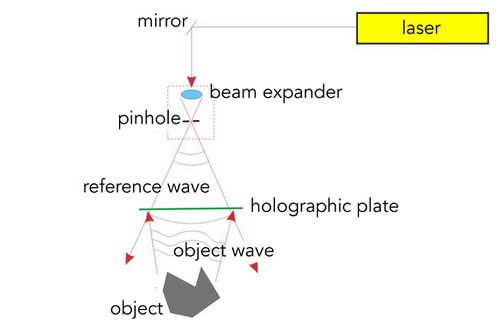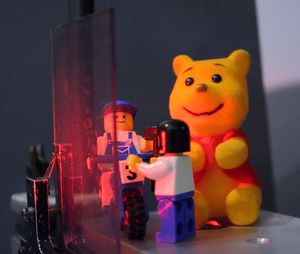Holography (Nobel Prize Physics in Everyday Application – Laboratory Exercise)
Tartalomjegyzék |
Introduction
Humans have three-dimensional vision. This is due to the fact that our two eyes see different images of the scene that we are looking at. Photography is a common way of recording what we see. In photography real objects are mapped onto a two-dimensional surface using the lens of a camera (formerly the recording surface used to be a film coated with a photosensitive material, but in today's digital cameras it is an electronic light-sensitive plate made up of pixels of a given size). When you look at the resulting photograph, even with two eyes, you cannot see a three-dimensional scene the way you see reality. This is because the photograph does not contain all the three-dimensional information about the light wave coming from the object.
In 1947, the Hungarian-born electrical engineer and physicist Dennis Gabor (1900-1979) conceived the basic idea of holography: instead of passing the light coming from an object through a lens that would image it onto a photosensitive film (as in conventional photography), this light wave, called the 'object wave', is directly projected onto the photosensitive plate, together with another light wave called the 'reference wave'. When the object wave and the reference wave are added, an interference image is formed on the photosensitive plate, which records the full three-dimensional information about the object wave. As the method is based on the interference of waves, a coherent light source emitting a monochromatic light wave is required to obtain a holographic image (e.g. sunlight or incandescent light is not suitable). It is no wonder that the field of holography only really began to make spectacular progress in the early 1960s with the invention of the laser. However, the few years that followed and the emergence of research fields such as holographic optical elements (HOEs), holographic interferometry, computer holography, reflection holography that still flourish today were enough to convince the Swedish Academy of Sciences committee to award Dennis Gabor the Nobel Prize in Physics in 1971. Since then, holography has expanded into many other important areas, such as holographic data storage and holographic security.
A hologram is therefore simply a system of dense interference fringes. To view the image of the object (i.e. to 'reconstruct' the hologram), we have to illuminate the holographic plate with the reference light wave. The illuminating light wave is then diffracted by the fixed, dense interference fringe system. It can be shown that one of the diffracted wave components will be precisely the object wave that was used to record the hologram. This reconstructed object wave can be viewed e.g. by moving the head to different viewpoints in the same way as the three-dimensional object itself. In addition to reproducing a spectacular three-dimensional image, a particularly exciting feature of holography is that information is distributed differently on a hologram than on traditional information storage media (e.g. a photograph, a DVD or a computer's magnetic hard disk). The connection between the object and the points ("pixels" or "bits") of the holographic storage device is not a one-to-one mapping: information is received and recorded at a given point on the hologram from all points on the object. Even when the hologram is broken into small pieces, the complete object information is preserved in each piece. In this measurement, you will create a reflection hologram and through it you will learn about many interesting and unique properties of holograms.
Recording a reflection hologram
The setup for recording reflection holograms is shown in Figure 1. The narrow beam of the laser is expanded by a lens to illuminate the entire holographic plate and the object behind the holographic plate. The reference wave is the light wave coming from the beam expander that hits the holographic plate from the front, and the object wave is the light wave that is scattered backwards from the object and hits the holographic plate from the other side. A particular setup is shown in Figure 2. The object (2 LEGO figures and a teddy bear) is seen on the right and the holographic plate is seen on the left.
| 1. ábra | 2. ábra |
The reference wave and the object wave are combined in the photosensitive layer of the hologram plate, creating interference. The interference image can be recorded with good quality if the intensity ratio of the two waves, as well as their combined intensity and the exposure time, are set appropriately. Since exposure times can be on the order of seconds or minutes, care must be taken to ensure that the interference image and the holographic plate do not move/shake with respect to each other during the recording. To achieve this the entire setup is placed on a special optical table that is vibration-free and sufficiently rigid. Other interfering effects (e.g. air currents, background light) must also be excluded during the recording.
In the lab we record a reflection hologram of a small, highly reflective, preferably shiny object on a holographic plate of appr. 5 cm x 7.5 cm (suitable objects include coins, keys, small metal ornaments, white LEGO elements, white objects with diffuse surfaces). The light source is a red laser diode with a wavelength of λ=650nm and a power of ~20mW. The holographic plates are LITIHOLO RRT20 type glass plates coated with a so-called instant film, sensitive to wavelengths of ~600-660 nm. The 50 μm thickness of the photosensitive layer is much greater than the illumination wavelength (the significance of this will be discussed in the next section.) The interference image is recorded over the full thickness of the photosensitive layer in the form of a refractive index change depending on the illumination intensity, creating a series of high and low refractive index interference surfaces. The distance between adjacent interference surfaces is λ/2, corresponding to the distance between adjacent nodes of standing waves formed by two counter-propagating waves.
The advantage of the LITIHOLO RRT20 plates used in the experiment is that they do not require any of the chemical processes (development, bleaching, fixing) used for conventional holographic emulsions, because the interference surfaces are fixed in the material during the recording process. The holographic plates are contained in a light-tight box, which should only be opened in the dark immediately before recording and then closed immediately after a plate is removed.
Reconstruction of a reflection hologram
After recording the hologram, which takes about a minute, we remove the object from its place and illuminate the holographic plate with only the reference wave, as described in the Introduction. What we will find is that, even in the absence of the object, the object wave is indeed reconstructed from the hologram alone: the object is seen "floating" in its original position behind the hologram plate, in its full three-dimensional reality. This type of hologram is called a reflection hologram because it acts as a mirror: the reconstructing reference wave is "reflected" back in an altered form, transformed into a reconstructed object wave. We will also try the following reconstruction arrangements:
- Flip the hologram so that the illuminating reference wave now illuminates the opposite side of the hologram. This is the so-called conjugate reconstruction arrangement. What do we experience: what does the so-called conjugate reconstructed object wave look like? In what way does it differ from the original reconstructed object wave, and in what sense does it present an "unrealistic" picture?
- The hologram is reconstructed not with the light of the laser diode that was used to record the image, but with a point-like white light source (e.g. sunlight, a spotlight, or a white LED). What colour is the reconstructed image of the object? Note: reflection holograms can be viewed in white light because, as we have seen, they are recorded on a plate with a photosensitive layer that is thick relative to the wavelength of the light source used, so a whole series of interference surfaces are recorded in the photosensitive layer. These interference surfaces are nearly parallel to each other, and the distance between two adjacent surfaces having the same refractive index is ~λ/2. A thick layer like this exhibits the so-called Bragg effect: if it is illuminated with white light, significant diffraction only occurs at wavelengths that are close to the wavelength used during the recording, thus producing a sharp, nearly monochromatic image of the object.
- Cover half of the hologram (or cut the hologram in half with a glass cutter) and illuminate the half-hologram with the reconstructing reference wave. What do you see? Do you see only half of the object or all of it? In what sense does the half-hologram contain information about the whole object?

